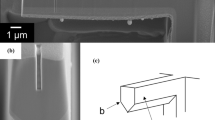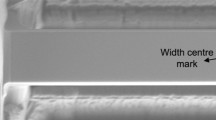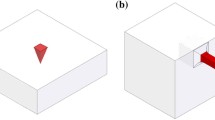Abstract
Although the time-dependent deformation behaviors of microscale materials have been investigated through experiments with uniaxial loading conditions, the influence of the strain gradient has not been clearly clarified due to the lack of appropriate testing methods. In the current study, to investigate the stress relaxation behavior of microscale single-crystal copper (Cu) at room temperature, a quantitative in situ SEM bending experiment is presented using microcantilever specimens of single-crystal Cu. The microcantilever specimens were fabricated using a focused ion beam, and a tungsten (W) layer was deposited onto the front surface to eliminate the error induced by the penetration of the stiff indenter into the metallic specimen. The yield stress of microscale single-crystal Cu is determined to be 445 MPa by a monotonic loading test, showing an apparent size effect, and no strain hardening is observed due to single-slip deformation. On the other hand, the stress relaxation behavior of the microscale single-crystal Cu consists of both a continuous stress relaxation and an abrupt stress decrease due to a strain burst. The activated volume in each dwell stage is obtained by thermodynamics theory and is found to be mainly related to the abrupt stress decrease. The value of the activated volume indicates that the continuous stress drops in the 1st and 2nd dwell stages are attributed to the evolution of dislocation structures by the single slip on system B4, while the dislocation pile-up near the neutral plane leads to the dominance of cross slip on the stress relaxation behavior in the bending plateau. The proposed microcantilever bending experiment is applicable to explore the time-dependent deformation behavior of small-scale materials.











Similar content being viewed by others
References
Xu F, Zhu Y (2012) Highly conductive and stretchable silver nanowire conductors. Adv Mater 24(37):5117–5122
Cheng T, Zhang Y, Lai WY, Huang W (2015) Stretchable thin-film electrodes for flexible electronics with high deformability and stretchability. Adv Mater 27(22):3349–3376
Wang X, Liu Z, Zhang T (2017) Flexible sensing electronics for wearable/attachable health monitoring. Small 13:1602790
Dong K, Choe HS, Wang X, Liu H, Saha B, Ko C, Deng Y, Tom KB, Lou S, Wang L, Grigoropoulos CP, You Z, Yao J, Wu J (2018) A 0.2 V micro-electromechanical switch enabled by a phase transition. Small 14:e1703621
Gómez-Cortés JF, Nó ML, Ruíz-Larrea I, Breczewski T, López-Echarri A, Schuh CA, San Juan JM (2019) Ultrahigh superelastic damping at the nano-scale: a robust phenomenon to improve smart MEMS devices. Acta Mater 166:346–356
Huang Y, Vasan ASS, Doraiswami R, Osterman M (2012) MEMS reliability review. IEEE Trans Device Mat Rel 12(2):482–493
Yoo B-G, Kim J-Y, Kim Y-J, Choi I-C, Shim S, Tsui TY, Bei H, Ramamurty U, Jang J-i (2012) Increased time-dependent room temperature plasticity in metallic glass nanopillars and its size-dependency. Int J Plast 37:108–118
Choi I-C, Kim Y-J, Seok M-Y, Yoo B-G, Kim J-Y, Wang Y, Jang J-i (2013) Nanoscale room temperature creep of nanocrystalline nickel pillars at low stresses. Int J Plast 41:53–64
Gu R, Ngan AHW (2014) Size-dependent creep of duralumin micro-pillars at room temperature. In J Plasticity 55:219–231
Kim Y-J, Qaiser N, Han SM (2016) Time-dependent deformation of Sn micropillars. Mater Des 102:168–173
Mohanty G, Wehrs J, Boyce BL, Taylor A, Hasegawa M, Philippe L, Michler J (2016) Room temperature stress relaxation in nanocrystalline Ni measured by micropillar compression and miniature tension. J Mater Res 31(8):1085–1095
Guo S, He Y, Liu D, Lei J, Li Z, Ding H (2017) Torsional stress relaxation behavior of microscale copper wire. Mater Sci Eng A 698:277–281
Guo S, He Y, Li Z, Lei J, Liu D (2019) Size and stress dependences in the tensile stress relaxation of thin copper wires at room temperature. Int J Plast 112:278–296
Bhowmick S, Espinosa H, Jungjohann K, Pardoen T, Pierron O (2019) Advanced microelectromechanical systems-based nanomechanical testing: beyond stress and strain measurements. MRS Bull 44(6):487–493
Kacher J, Kirchlechner C, Michler J, Polatidis E, Schwaiger R, Van Swygenhoven H, Taheri M, Legros M (2019) Impact of in situ nanomechanics on physical metallurgy. MRS Bull 44(6):465–470
Motz C, Schöberl T, Pippan R (2005) Mechanical properties of micro-sized copper bending beams machined by the focused ion beam technique. Acta Mater 53(15):4269–4279
Motz C, Weygand D, Senger J, Gumbsch P (2008) Micro-bending tests: a comparison between three-dimensional discrete dislocation dynamics simulations and experiments. Acta Mater 56(9):1942–1955
Kiener D, Motz C, Rester M, Jenko M, Dehm G (2007) FIB damage of Cu and possible consequences for miniaturized mechanical tests. Mater Sci Eng A 459(1–2):262–272
Uchic MD, Shade PA, Dimiduk DM (2009) Plasticity of micrometer-scale single crystals in compression. Annu Rev Mater Res 39(1):361–386
Demir E, Raabe D (2010) Mechanical and microstructural single-crystal Bauschinger effects: observation of reversible plasticity in copper during bending. Acta Mater 58(18):6055–6063
Zhu Y, Ke C, Espinosa HD (2007) Experimental techniques for the mechanical characterization of one-dimensional nanostructures. Exp Mech 47:7–24
Takahashi Y, Arai S, Yamamoto Y, Higuchi K, Kondo H, Kitagawa Y, Muto S, Tanaka N (2015) Evaluation of interfacial fracture strength in micro-scale components combined with high-voltage environmental electron microscopy. Exp Mech 55:1047–1056
Fan S, Jiang C, Lu H, Li F, Yang Y, Shen Y, Lu Y (2019) In situ micromechanical characterization of metallic glass microwires under torsional loading. Exp Mech 59(3):361–368
Yan Y, Sumigawa T, Guo L, Kitamura T (2018) Fracture nanomechanics. In: Hsueh CH, Schmauder S, Chen CS, Chawla KK, Chawla N, Chen W, Kagawa Y (eds) Handbook of mechanics of materials. Springer, Singapore, pp 1–38
Yan Y, Sumigawa T, Kitamura T (2018) A robust in situ TEM experiment for characterizing the fracture toughness of the tnterface in nanoscale multilayers. Exp Mech 58(5):721–731
Sumigawa T, Matsumoto K, Tsuchiya T, Kitamura T (2012) Fatigue of 1μm-scale gold by vibration with reduced resonant frequency. Mater Sci Eng A 556:429–436
Sumigawa T, Byungwoon K, Mizuno Y, Morimura T, Kitamura T (2018) In situ observation on formation process of nanoscale cracking during tension-compression fatigue of single crystal copper micron-scale specimen. Acta Mater 153:270–278
Kiener D, Motz C, Grosinger W, Weygand D, Pippan R (2010) Cyclic response of copper single crystal micro-beams. Scr Mater 63(5):500–503
Wimmer A, Heinz W, Detzel T, Robl W, Nellessen M, Kirchlechner C, Dehm G (2015) Cyclic bending experiments on free-standing cu micron lines observed by electron backscatter diffraction. Acta Mater 83:460–469
Bufford DC, Stauffer D, Mook WM, Syed Asif SA, Boyce BL, Hattar K (2016) High cycle fatigue in the transmission electron microscope. Nano Lett 16(8):4946–4953
Zhang H, Jiang C, Lu Y (2016) Low-cycle fatigue testing of Ni nanowires based on a micro-mechanical device. Exp Mech 57(3):495–500
Barrios A, Gupta S, Castelluccio GM, Pierron ON (2018) Quantitative in situ SEM high cycle fatigue: the critical role of oxygen on nanoscale-void-controlled nucleation and propagation of small cracks in Ni microbeams. Nano Lett 18(4):2595–2602
Zhong L, Sansoz F, He Y, Wang C, Zhang Z, Mao SX (2017) Slip-activated surface creep with room-temperature super-elongation in metallic nanocrystals. Nat Mater 16(4):439–445
Hirakata H, Shimbara K, Kondo T, Minoshima K (2018) Size effect on tensile creep behavior of micrometer-sized single-crystal gold. Materialia 1:221–228
Hosseinian E, Legros M, Pierron ON (2016) Quantifying and observing viscoplasticity at the nanoscale: highly localized deformation mechanisms in ultrathin nanocrystalline gold films. Nanoscale 8(17):9234–9244
Gupta S, Pierron O (2017) A MEMS tensile testing technique for measuring true activation volume and effective stress in nanocrystalline ultrathin microbeams. J Microelectromech Syst 26(5):1082–1092
Suresh S, Nieh TG, Choi BW (1999) Nano-indentation of copper thin films on silicon substrates. Scr Mater 41(9):951–957
Saha R, Nix WD (2001) Soft films on hard substrates-nanoindentation of tungsten films on sapphire substrates. Mater Sci Eng A 319–321:898–901
Kiener D, Motz C, Schöberl T, Jenko M, Dehm G (2006) Determination of mechanical properties of copper at the micron scale. Adv Eng Mater 8(11):1119–1125
Demir E, Raabe D, Roters F (2010) The mechanical size effect as a mean-field breakdown phenomenon: example of microscale single crystal beam bending. Acta Mater 58(5):1876–1886
Feltham P, Spears CJ (2013) Stress relaxation in single crystals of copper and α-brasses. Metal Sci J 2(1):183–186
Dotsenko VI (1979) Stress relaxation in crystals. Phys Status Solidi B 93:11–43
Yang XS, Wang YJ, Wang GY, Zhai HR, Dai LH, Zhang TY (2016) Time, stress, and temperature-dependent deformation in nanostructured copper: stress relaxation tests and simulations. Acta Mater 108:252–263
Wang Y, Hamza A, Ma E (2006) Temperature-dependent strain rate sensitivity and activation volume of nanocrystalline Ni. Acta Mater 54(10):2715–2726
Lu L, Zhu T, Shen Y, Dao M, Lu K, Suresh S (2009) Stress relaxation and the structure size-dependence of plastic deformation in nanotwinned copper. Acta Mater 57(17):5165–5173
Acknowledgements
This work was supported by National Natural Science Foundation of China (Grant Nos. 21835003, 11602252), Natural Science Foundation of Shanghai (Grant No. 19ZR1413200), Fundamental Research Funds for the Central Universities (Grant No. 50321071915017), Program for Professor of Special Appointment (Eastern Scholar) at Shanghai Institutions of Higher Learning, and JSPS KAKENHI Grant Numbers 18H03753, 18K18807, 18H05241.
Author information
Authors and Affiliations
Corresponding authors
Ethics declarations
Conflict of Interest
The authors declare that they have no conflict of interest.
Additional information
Publisher’s Note
Springer Nature remains neutral with regard to jurisdictional claims in published maps and institutional affiliations.
Rights and permissions
About this article
Cite this article
Yan, Y., Chen, W., Sumigawa, T. et al. A Quantitative In Situ SEM Bending Method for Stress Relaxation of Microscale Materials at Room Temperature. Exp Mech 60, 937–947 (2020). https://doi.org/10.1007/s11340-020-00611-7
Received:
Accepted:
Published:
Issue Date:
DOI: https://doi.org/10.1007/s11340-020-00611-7




